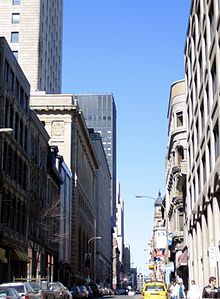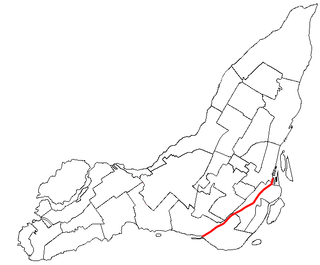
The Lachine Canal is a canal passing through the southwestern part of the Island of Montreal, Quebec, Canada, running 14.5 kilometres from the Old Port of Montreal to Lake Saint-Louis, through the boroughs of Lachine, Lasalle and Sud-Ouest.
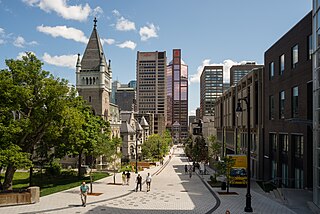
The architecture of Montreal, Quebec, Canada is characterized by the juxtaposition of the old and the new and a wide variety of architectural styles, the legacy of two successive colonizations by the French, the British, and the close presence of modern architecture to the south. Much like Quebec City, the city of Montreal had fortifications, but they were destroyed between 1804 and 1817.

The Molson Bank was a Canadian bank founded in Montreal, Quebec, by brothers William (1793–1875) and John Molson, Jr. (1787–1860), the sons of brewery magnate John Molson.
Pointe-Saint-Charles is a neighbourhood in the borough of Le Sud-Ouest in the city of Montreal, Quebec, Canada. Historically a working-class area, the creation of many new housing units, the recycling of industrial buildings into business incubators, lofts, and condos, the 2002 re-opening of the canal as a recreation and tourism area, the improvement of public spaces, and heritage enhancement have all helped transform the neighbourhood and attract new residents. Community groups continue to be pro-active in areas related to the fight against poverty and the improvement of living conditions.

Place-Saint-Henri station is a Montreal Metro station in the borough of Le Sud-Ouest in Montreal, Quebec, Canada. It is operated by the Société de transport de Montréal (STM) and serves the Orange Line. It is located in the Saint-Henri neighbourhood.
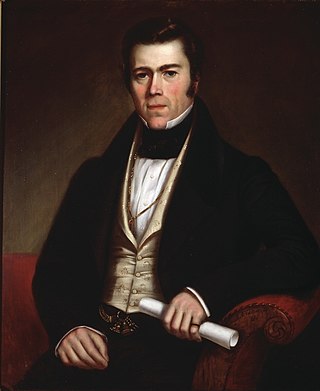
John Redpath was a Scots-Quebecer businessman and philanthropist who helped pioneer the industrial movement that made Montreal, Quebec, the largest and most prosperous city in Canada.

Ville-Marie is the name of a borough (arrondissement) in the centre of Montreal, Quebec. The borough is named after Fort Ville-Marie, the French settlement that would later become Montreal, which was located within the present-day borough. Old Montreal is a National Historic Site of Canada.

Le Sud-Ouest is a borough (arrondissement) of the city of Montreal, Quebec, Canada.
Notre-Dame-de-Grâce was a federal electoral district in Quebec, Canada, that was represented in the House of Commons of Canada from 1949 to 1997.

Old Montreal is a historic neighbourhood within the municipality of Montreal in the province of Quebec, Canada. Home to the Old Port of Montreal, the neighbourhood is bordered on the west by McGill Street, on the north by Ruelle des Fortifications, on the east by rue Saint-André, and on the south by the Saint Lawrence River. Following recent amendments, the neighbourhood has expanded to include the Rue des Soeurs Grises in the west, Saint Antoine Street in the north, and Saint Hubert Street in the east.

The Bank of Montreal's Head Office is located on 119, rue Saint Jacques in Montreal, Quebec, Canada, across the Place d'Armes from the Notre-Dame Basilica in the Old Montreal neighbourhood. The Bank of Montreal is the oldest bank in Canada, founded in 1817. Although it still remains the bank's legal headquarters, its operational head office was moved to First Canadian Place in Toronto in 1977 due to political instability in Quebec.

The Molson Bank Building was built at the corner of St. Peter and St. James streets in the Old Montreal neighbourhood of Montreal, Quebec as the headquarters of the Molson Bank in 1866 by order of founder William Molson (1793-1875). It was the first building in Montreal to be built in the Second Empire style, designed by George Browne working with his son John James George Browne.
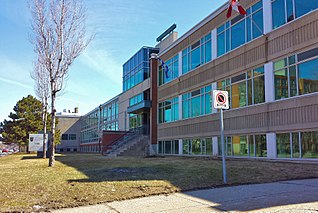
The Centre de services scolaire Marguerite-Bourgeoys is an autonomous school service centre on Montreal Island, Quebec, Canada, appointed by the Ministry of Education.
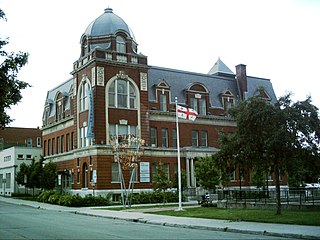
Little Burgundy is a neighbourhood in the South West borough of the city of Montreal, Quebec, Canada.

Peel Street (officially in French: rue Peel) is a major north–south street located in downtown Montreal, Quebec, Canada. The Street links Pine Avenue, near Mount Royal, in the north and Smith Street, in the Southwest borough, in the south. The street's southern end is at the Peel Basin of the Lachine Canal. The street runs through Montreal's shopping district. The Peel Metro station is named for the street.

Notre-Dame Street is a historic east–west street located in Montreal, Quebec, Canada. It runs parallel to the Saint Lawrence River, from Lachine to the eastern tip of the island in Pointe-aux-Trembles, then continuing off the island into the Lanaudière region.

Saint Antoine Street, formerly known as Craig Street, is a street located in Montreal, Quebec, Canada. It runs to the south of Downtown Montreal and north of Old Montreal and Griffintown and Saint-Henri. It crosses the Quartier international de Montréal. Between Atwater Avenue and Greene Avenue, the north side of the street is in Westmount.
The timeline of Montreal history is a chronology of significant events in the history of Montreal, Canada's second-most populated city, with about 3.5 million residents in 2018, and the fourth-largest French-speaking city in the world.
